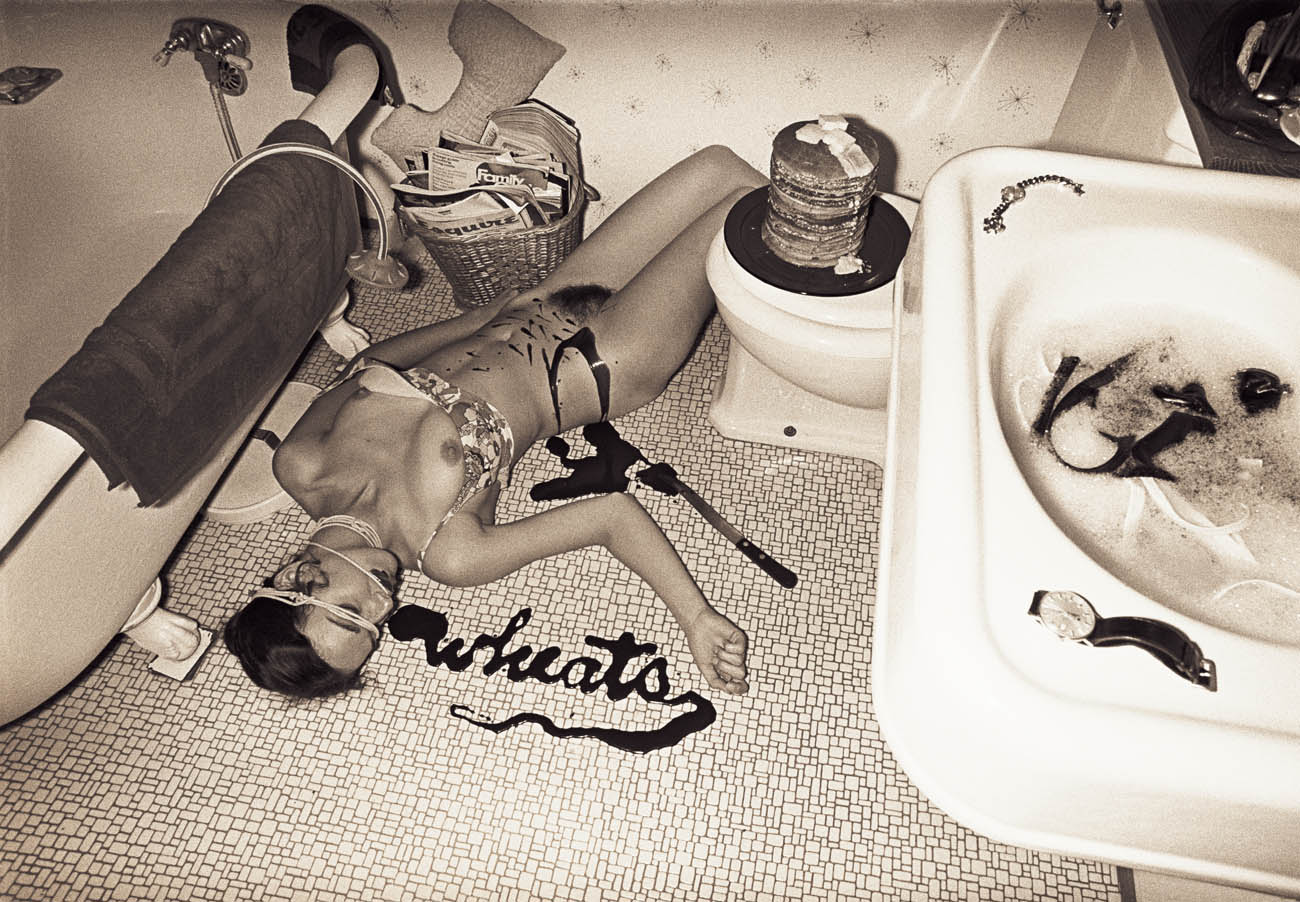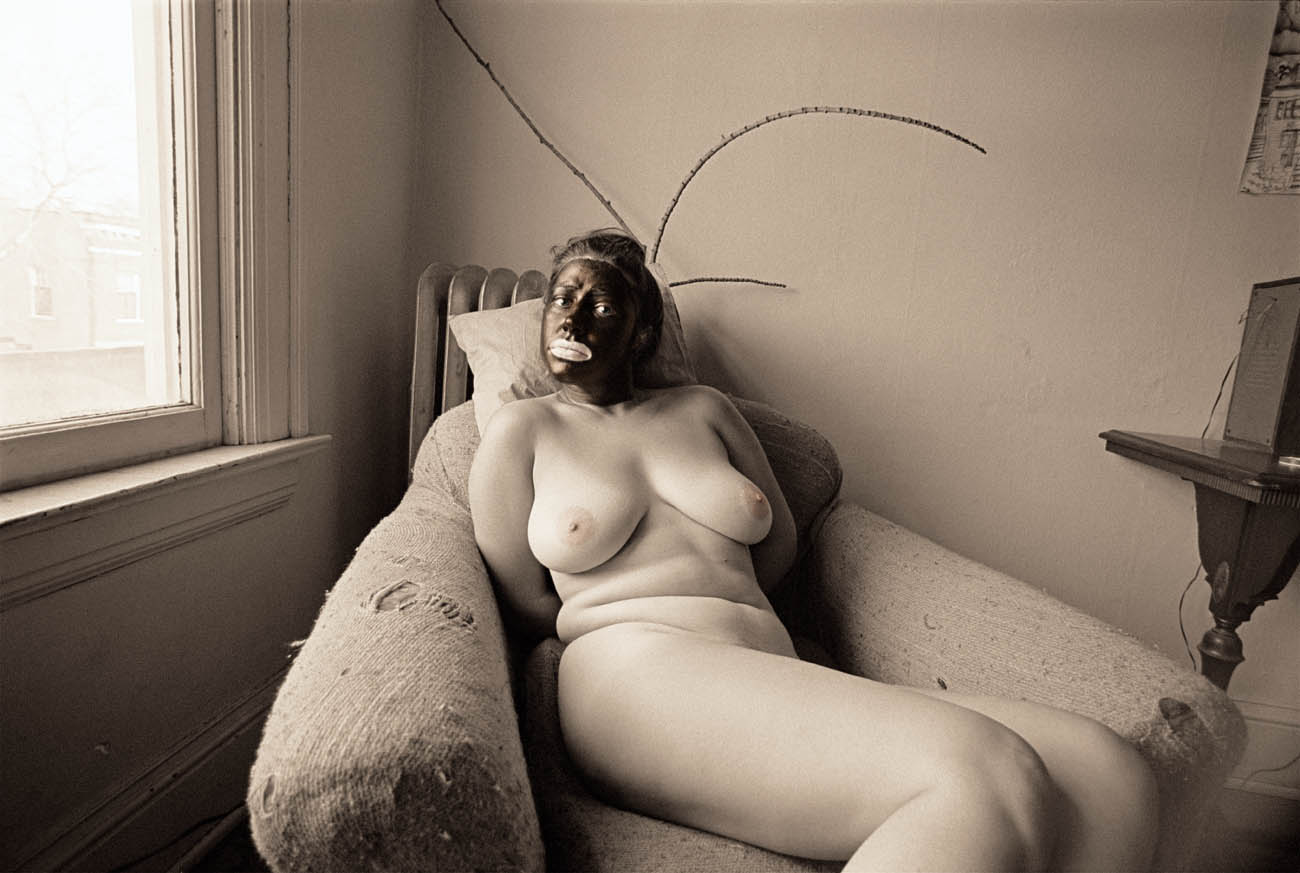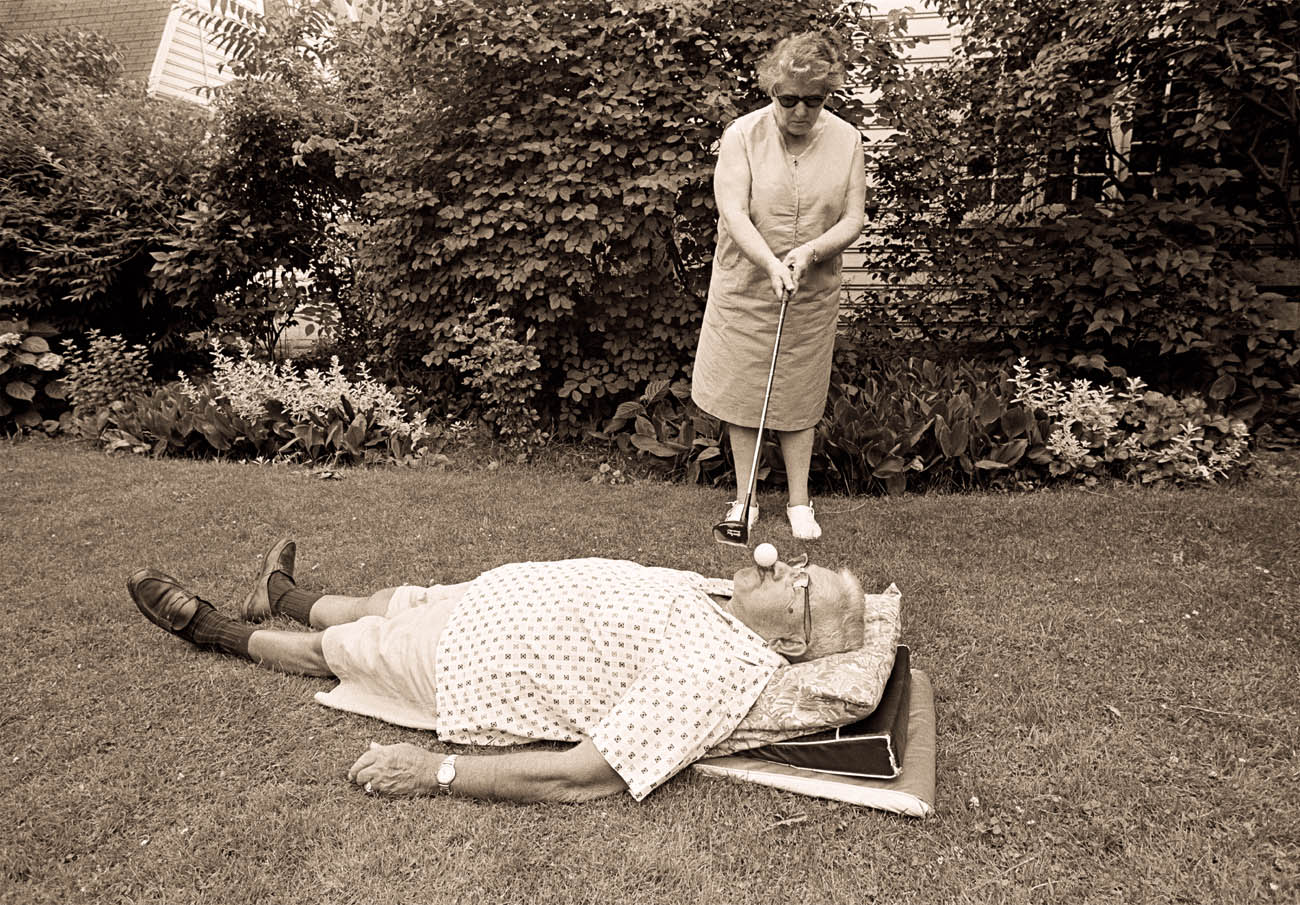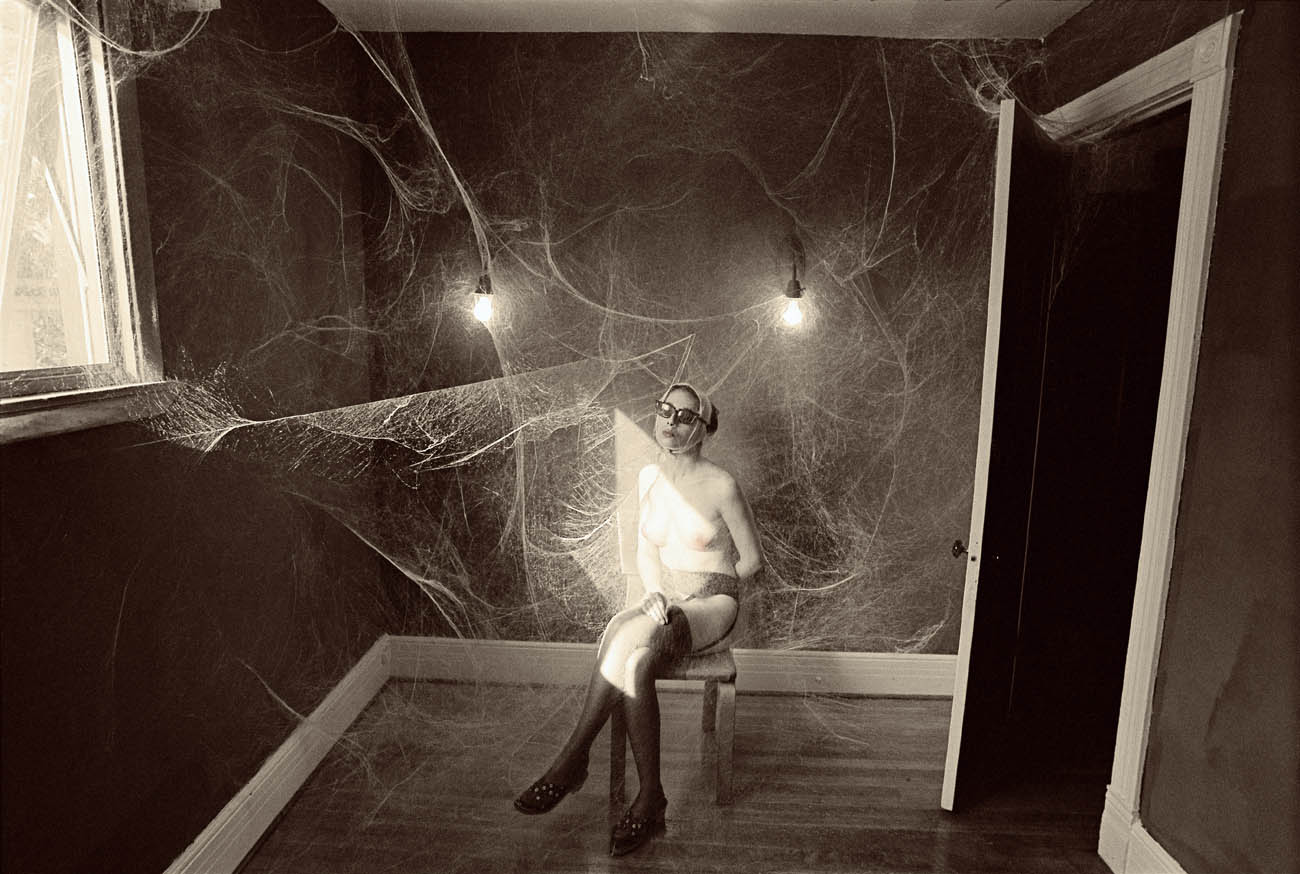Purple Magazine
— S/S 2011 issue 15
Les Krims
 Stack o’ Wheats Murder #9 Celestial Choclate Syrup Simulated Blood Puddle (from The Incredible Case of the Stack o’ Wheats Murders), Buffalo New York, 1970<br />Printed by Les Krims, in a Basement Near the Boiler Room, in Buffalo, New York – a Failed Border Town Where the Stank of Goverment Cheese Meets the E-Coli Scented Lake Erie Breeze.
Stack o’ Wheats Murder #9 Celestial Choclate Syrup Simulated Blood Puddle (from The Incredible Case of the Stack o’ Wheats Murders), Buffalo New York, 1970<br />Printed by Les Krims, in a Basement Near the Boiler Room, in Buffalo, New York – a Failed Border Town Where the Stank of Goverment Cheese Meets the E-Coli Scented Lake Erie Breeze.
 Sally Krims with Guns in Her Bra, and Cross-Eyed Woman, 1970<br />Printed by Les Krims, in a Basement Near the Boiler Room, in Buffalo, New York – a Failed Border Town Where the Stank of Goverment Cheese Meets the E-Coli Scented Lake Erie Breeze.
Sally Krims with Guns in Her Bra, and Cross-Eyed Woman, 1970<br />Printed by Les Krims, in a Basement Near the Boiler Room, in Buffalo, New York – a Failed Border Town Where the Stank of Goverment Cheese Meets the E-Coli Scented Lake Erie Breeze.
 Nude with Squirting Penis Drawings, Rochester, New York, 1969<br />Printed by Les Krims in a Basement in Buffalo, New York – Home of The Love Glove, Sepent Socket, Fish Mitten, Grandest Canyon, Dick Dungeon, Vacuum Vulva, Skin Canoe, Bearded Taco, Panty Hampster, Meat Tunnel, Love Cave, Cream Canal, Salami Garage, Pink Truffle, Spasm Chasm, Wombsday Book, Twatlantic Ocean and Lawrence of a Labia.
Nude with Squirting Penis Drawings, Rochester, New York, 1969<br />Printed by Les Krims in a Basement in Buffalo, New York – Home of The Love Glove, Sepent Socket, Fish Mitten, Grandest Canyon, Dick Dungeon, Vacuum Vulva, Skin Canoe, Bearded Taco, Panty Hampster, Meat Tunnel, Love Cave, Cream Canal, Salami Garage, Pink Truffle, Spasm Chasm, Wombsday Book, Twatlantic Ocean and Lawrence of a Labia.
 Wheats, 1970 (from The Incredible Case of the Stack o’ Wheats Murders), Buffalo New York, 1970<br />Printed by Les Krims, in a Basement Near the Boiler Room, in Buffalo, New York – a Failed Border Town Where the Stank of Goverment Cheese Meets the E-Coli Scented Lake Erie Breeze.
Wheats, 1970 (from The Incredible Case of the Stack o’ Wheats Murders), Buffalo New York, 1970<br />Printed by Les Krims, in a Basement Near the Boiler Room, in Buffalo, New York – a Failed Border Town Where the Stank of Goverment Cheese Meets the E-Coli Scented Lake Erie Breeze.
 Student Feminist Activist Nude in Blackface (from The Incredible Case of the Stack o’ Wheats Murders), Buffalo New York, 1970<br />Printed by Les Krims, in a Basement Near the Boiler Room, in Buffalo, New York – a Failed Border Town Where the Stank of Goverment Cheese Meets the E-Coli Scented Lake Erie Breeze.
Student Feminist Activist Nude in Blackface (from The Incredible Case of the Stack o’ Wheats Murders), Buffalo New York, 1970<br />Printed by Les Krims, in a Basement Near the Boiler Room, in Buffalo, New York – a Failed Border Town Where the Stank of Goverment Cheese Meets the E-Coli Scented Lake Erie Breeze.
 Mrs. BraveRman an Early Feminist, Teeing a Golf Ball in Her Husband’s Mouth Much as Racists Did for Laughs with Black Caddies in the Segregated South, Rochester, New York 1968<br />Printed by Les Krims, in a Basement Near the Boiler Room, in Buffalo, New York – a Failed Border Town Where the Stank of Goverment Cheese Meets the E-Coli Scented Lake Erie Breeze.
<img class="alignsize-medium wp-image-154316" src="https://static.purple.fr/2015/07/AcademicArtWords11-300×237.jpg"), Buffalo, New York, 1977
Mrs. BraveRman an Early Feminist, Teeing a Golf Ball in Her Husband’s Mouth Much as Racists Did for Laughs with Black Caddies in the Segregated South, Rochester, New York 1968<br />Printed by Les Krims, in a Basement Near the Boiler Room, in Buffalo, New York – a Failed Border Town Where the Stank of Goverment Cheese Meets the E-Coli Scented Lake Erie Breeze.
<img class="alignsize-medium wp-image-154316" src="https://static.purple.fr/2015/07/AcademicArtWords11-300×237.jpg"), Buffalo, New York, 1977Printed by Les Krims, in a Basement Near the Boiler Room, in Buffalo, New York – a Failed Border Town Where the Stank of Goverment Cheese Meets the E-Coli Scented Lake Erie Breeze.
 Nude with Cobwebs, Fargo Avenue, 1969<br />Printed by Les Krims, in a Basement Near the Boiler Room, in Buffalo, New York – a Failed Border Town Where the Stank of Goverment Cheese Meets the E-Coli Scented Lake Erie Breeze.
Nude with Cobwebs, Fargo Avenue, 1969<br />Printed by Les Krims, in a Basement Near the Boiler Room, in Buffalo, New York – a Failed Border Town Where the Stank of Goverment Cheese Meets the E-Coli Scented Lake Erie Breeze.
interview by JEN BRILL
All images copyright Les Krims
The 68-year-old American photographer Les Krims had a reputation for being prolific, perversely conceptual, and provocatively anti-academic. From the manipulated polaroids of “Fictcryptokrimsographs” (1975) to the conceptual “Idiosyncratic Pictures” (1980), Krims relentlessly upended the cardinal values of the American way of life and its belief systems. In spontaneously arranged photographic fictions, he satirized forensic photography, feminist activism, and academic art, along with a short people’s convention and the making of chicken soup. In the process he devised a unique form of documentary anti-portraiture.
JEN BRILL — What part of Brooklyn did you grow up in? What did your parents do for a living?
LES KRIMS — I grew up in Bensonhurst — 63rd Street and 24th Avenue, to be exact. My parents split up when I was seven. My father owned a small shop in downtown Brooklyn, where he sold handbags and gloves. After the divorce my mother worked in neighborhood shops selling lingerie, and later for a business on Coney Island Avenue that made window blinds.
JEN BRILL — Were you exposed to art or photography at a young age? What was your first introduction to it? Do you remember the first image or the first work that struck a chord?
LES KRIMS — When I was a kid my mother made snapshots with an old Ansco camera. She gave me art supplies — oil paints, brushes, canvas board — and encouraged me to draw and paint. To my amazement, my lousy drawings entertained even the toughest kids in grade school. Later I studied art at Cooper Union, which had a great art library. It had subscriptions to art magazines from all over the world. I liked editorial and fashion photographers the best — Art Kane, Jeanloup Sieff, Hiro, Avedon, Irving Penn, and many others. I remember seeing a copy of William Klein’s Tokyo. The pictures and format were great! It was printed with matte ink on matte paper.
JEN BRILL — Were your parents supportive of your decision to become an artist?
LES KRIMS — Yes. My mother loved it that I was accepted to The Cooper Union. I started with architecture, but switched to art after the foundation year. There was no objection. I studied art at The Cooper Union for the Advancement of Science and Art from 1960 to 1964, and then went to Pratt to get my MFA. Before I got to Pratt, which I started attending in January of 1965, I did page layout for Art Voices, an art magazine with offices in the Fuller Building. At Pratt I studied painting and printmaking but did my thesis show in photography.
JEN BRILL — What did you do after Pratt?
LES KRIMS — I worked a couple of months for John Naso, a commercial photographer who had taught design at Cooper Union. He had a great studio overlooking Gramercy Park. I was living in a terrible place in Bedford-Stuyvesant. I got a call from Peter Bunnell at MoMA. He recommended me to his friend Brad Hindson for a teaching job at Rochester Institute of Technology. I eagerly took it, left New York City, and worked in Rochester for a couple of years. Then in September 1969, I moved to Buffalo to teach photography at Buffalo State College.
JEN BRILL — When did you start taking photographs? Which camera were you using?
LES KRIMS — I began photography in graduate school, in 1965. I used a Yashica Mat, and then I switched to a Nikon. There was no formal instruction in photography at Pratt. In fact, there was no formal instruction in any graduate art area. One just had access to a studio and an easel, and to a black-and-white lab to develop film and make enlargements. I had the good fortune not to be indoctrinated into any kind of photographic aesthetic. I made it up as I went along.
JEN BRILL — How did you meet the avant-garde filmmaker Hollis Frampton?
LES KRIMS — We met in Buffalo through a mutual friend. Hollis taught at the University of Buffalo. I asked Hollis to write the introduction to my offset book, Fictcryptokrimsographs, and he agreed. We never collaborated on any other project. From time to time we’d have dinner, smoke cigarettes, and drink wine. He invited me to his farm for a weekend and showed me how to use a 16mm motion picture camera. I had the idea to make a series of short — very short — films, which I called 10 Cheap Tricks. The tricks were inexpensive magic tricks for children. I filmed the tricks being performed. I still have the reel of film somewhere. I never screened it.
JEN BRILL — Were you friends with any of the artists involved with The Hallwalls Contemporary Art Center in Buffalo?
LES KRIMS — I knew them as students at BSC, but only slightly — Cindy Sherman, Robert Longo, Charles Clough. They were about ten years younger than me. My girlfriend at the time was their age. She knew them better than I did.
JEN BRILL — Whom do you consider your contemporaries?
LES KRIMS — That’s tough to answer. I met Duane Michals in 1968 or 1969, at my first exhibition at the Witkin Gallery. He was kind, and funny. I liked his work. I lived in Buffalo, 450 miles from New York City. There was no one in Buffalo doing what I was doing. Buffalonians made fun of my New York accent. Buffalo’s population at that time was over 600,000. The population today is a chicken wing more than 200,000. The first really good photographers I met were in Paris. The French book editor Bob Delpire — the great Bob Delpire! — saw my pictures somewhere and got in touch with me. He gave me a show at his gallery at 13 rue de l’Abbaye, in ’74 or ’75. I flew over for the opening. I’d never been to Europe. I couldn’t believe how beautiful Paris was. I wound up being invited to Henri Cartier-Bresson’s home for a couple of meals. He was Bob’s friend. I also had the good fortune to meet Jeanloup Sieff and Bernard Plossu. Cartier-Bresson asked me to accompany him to his printer, Gassman, to offer an objective opinion and to help him edit a group of 300 pictures he was selling to a museum in Japan. There wasn’t one dud. That was a treat! Of course, I met Bob’s wife, the wonderful, brilliant, fashion photographer, Sarah Moon.
JEN BRILL — How did the style of your photography change from reportage — like the portfolios, The Little People of America (1971) and Deerslayers (1972) — to conceptual works like The Incredible Case of…, Making Chicken Soup, and Fictocryptokrimsographs?
LES KRIMS — The conceptual work began long before the offset portfolios were published. The Deerslayers and The Little People of America parodied journalism. The two were coupled with The Incredible Case of the Stack o’ Wheats Murders — a purely fictional, fabricated, conceptual work. They were all printed together, sharing press sheets. Considered together, they were meant to needle aspects of past and present practices of photographers — to drive a stake through the heart of what I thought of as “concerned photography.” I presented faceted works that objectified a conceptual, fictional method of using a camera. In 1972, when I showed those works at The Witkin Gallery, along with 25 single-image “fictions,” I meant to underscore the fact that a photographic image is always an illusion, and that my pictures were fabricated. There were no other full-time commercial photography galleries in NYC, and maybe two or three others in all of the States. The people I’d meet in the small world of art-photography had little or no idea what conceptual art was. Slumming was still what motivated a lot of photographs. Nobody understood what I was doing. And nobody was interested, except Lee Witkin. All those “photo world” folks had been trained as photographers. Photography, in 1968, did not overlap other areas of art-making much. You have to remember the arbiters of provenance of a photograph in the late ’60s were antique dealers. They referred to photography as “old paper.” Light Gallery still hadn’t opened. Most painters and gallery owners told you photography wasn’t art. I thought it was.
JEN BRILL — Did Humpy Press, which you founded, publish any books aside from your own?
LES KRIMS — No. Humpy Press was created to publish Fictcryptokrimsographs. Did you know that you can flip the pages of that book flip-book style and watch Humpy take a bow? I don’t know if anyone ever noticed that. Humpy bows out in that book.
JEN BRILL — When did you get your first Polaroid?
LES KRIMS — I bought my SX-70 in 1974. My friend David Cahn, a radio personality in Buffalo, bought one in ’73. He showed me that the emulsion could be distorted using a ballpoint pen. Neat! After I published Fictcryptokrimsographs, I never used SX-70 film again. It had lousy color. The prints were small and not all that sharp. I’ve scanned many of the original prints in Fictcryptokrimsographs. They’re now color-corrected and sharpened, and they look much better.
JEN BRILL — Lucas Samaras bought his first SX 70 in ’73. Had you seen his Polaroids before you starting experimenting with the SX 70? Were you inspired by them?
LES KRIMS — I did see Samaras’ work around the time I bought my camera. I liked his pictures. I, too, thought I’d enjoy the ability to move the emulsion around. This must have been what inspired the geniuses who created Photoshop to make the liquify filter, which does an even better job.
JEN BRILL — How was your work perceived in the ’70s? Were people able to see the humor in it, or were they insulted? There are rumors that your work caused a kidnapping! Is that true?
LES KRIMS — A 14-year-old-boy was kidnapped in Memphis, Tennessee, in 1971. In the November 2009 issue of Memphis, The City Magazine, a story by Michael Finger explored aspects of that event and the events leading up to it. The ransom for the boy’s release was the demand to remove my pictures from an exhibition at the Memphis Academy of Art. There was little context for my work at that time. Socially motivated and “concerned” photographers held sway. Only gradually did that begin to change, over the next ten years. By the end of that decade I’d become the scapegoat for radical feminists emerging in the Society for Photographic Education. Andrea Dworkin had the hots for me. However, almost from the beginning, I found an audience in Paris, in Europe, and in Japan. That in itself was astounding, especially for a guy from Bensonhurst, Brooklyn. Nobody would publish my pictures here. That hasn’t changed.
JEN BRILL — Tell me about the women in your photos? How did you cast your shoots then? Friends? Family? Did you sleep with your subjects?
LES KRIMS — The women in my pictures were friends, models who worked at BSC, or my wife. I had no criteria other than that they liked what I did and were interested in working with me. My first wife was in numerous early pictures — yes, I did sleep with her. I did not sleep with the others.
JEN BRILL — Would you have a concept and then call your collaborators over to shoot? Or did the shoots happen more organically?
LES KRIMS — I planned each picture. Sometimes I made a small, simple sketch to note the idea and begin the process. I then had to find the people and an environment. Doing this was fairly straightforward. In the ’80s the environment for a picture got more complicated. They became allegorical, and fabricating a picture took more time. I moved away from tableau in the late ’80s, when it became clear I needed a crew of people to do things. And as a new father, I didn’t have the spare time or the energy. In any case, I was doing more candid work, which I’d never stopped doing — I like all sorts of camera work. I also began evolving new ways to “spin” a photographic image — to change how its nominal subject is perceived. I discovered that a candid, or found, image could function just as well as one that’s fabricated. My titles became rants or short-short stories inspired not by ideology or a prior conception but by the picture itself, after it had been made. I was editorializing. I was now attempting to parody liberal media, which after The Great Society and The New Journalism began in the mid-60s went completely wacky and became biased.
JEN BRILL — Were drugs involved?
LES KRIMS — No drugs. Cameras didn’t have automatic shutters then. I can’t imagine trying to do anything on drugs.
JEN BRILL — When did you start photographing your mother? And what did your father think of the photos you took of her?
LES KRIMS — That was in 1965. My mother volunteered one day when I complained that I couldn’t find a model to work with at Pratt. I was still living at home with her. I photographed Sally seated on her plastic-covered couch. She wore only white panties. She was modest. Such leaps were a lot less complicated for working-class people, crowded together as we were. I grew up living in two rooms. Modesty wasn’t in great supply. By then my parents had been divorced for almost 20 years. My father had twice married the same showgirl and was living in Las Vegas. I couldn’t wait to do my European tour, fuck my therapist, and enter the family business.
JEN BRILL — Do you have children?
LES KRIMS — Yes, I have a smart, tough, beautiful daughter — fortunately, she takes after my wife.
JEN BRILL — Would you get naked for your kid if she wanted to photograph you nude, perhaps baking a pie?
LES KRIMS — If she became a serious artist and wanted to make a picture of me without clothes I would certainly pose for her. However, she’s a stockbroker, and I doubt that will happen. She and I have been lucky enough to wind up doing things we each enjoy.
JEN BRILL — Do you ever photograph your students?
LES KRIMS — I never photographed my students while they were my students. That’s not good form.
JEN BRILL — Do you still photograph women?
LES KRIMS — For the last 20 years I haven’t photographed women that much. I went on strike. But I’ve recently begun to make photographs of women again. I’m enjoying it, and I would like to make more. But it’s hard in Buffalo for a 68-year-old man to find women who want to make odd pictures with him. Forty years of politically correct indoctrination has worked wonders. It’s a shame, because as an artist and as a craftsman, I’m the best I’ve ever been, and I know the pictures would be super-sweet.
END











































































































































